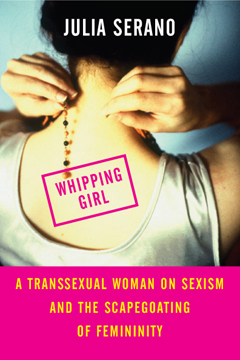I’ve just finished reading Whipping Girl by Julia Serano (I’ll post reviews of the books in the backlog when I have time but it makes sense to me to post reviews of more recent reads as I finish them, while they’re still fresh in my mind). My housing co-op has a small and growing library of books on class, gender, race, disability, sexuality etc for members to read. I’d heard of Whipping Girl before, so when it was added to the collection I decided I should borrow it and see what I thought.
It was published a few years ago now and in the intervening time I’d come across the main arguments that Serano makes in various articles and blogs and, hearteningly, in discussion within the queer/trans community. I imagine that it would have made more of an impact on me if I’d read it when it first came out. I’m certainly not as enthusiastic as some other folk who’ve read it but I’d say it’s well worth reading and thinking about.
Serano starts out with a Trans Woman Manifesto. You can watch Samantha from TrannyStarGalactica reading it out on the video below.
She rails against the discrimination that trans women face in a very clear, accessible way. Basically, she argues that society, including queer/trans subculture, devalues femaleness and femininity which means that trans women are faced with transmisogyny on top of transphobia, cissexism and traditional sexism. She also spends much of the book explaining terminology and critiquing medical and sociological theories about transsexuals, especially trans women. This didn’t grab me personally but I reckon it’d make a good primer for someone who is new to the ideas and issues.
What I most valued in this book was the argument that the trans movement must be a feminist movement: that as well as challenging the gender binary, we also need to challenge the notion that maleness is better than femaleness and masculinity is better than femininity. Transmisogny definitely a problem within the queer/trans movement and the feminist movement, as well as general society. Women’s events which implicity or, too often, explicity exclude trans women are all too common and it drives me up the wall when queer groups and events idolize hot, white, slim, androgynous bois to the exclusion of all else. I’ve seen more awareness of transmisogyny over the last few years but there’s a long way to go yet.
Also, in more timely news, they’ve amended the DSM (Diagnostic and Statistical Manual of Mental Disorders) and not only are trans people still disordered, they’ve massively extended the definition of Transvestic Disorder. As I understand it the diagnosis can be applied to anyone who is sexually active whilst wearing clothing that is incongruent with the sex they were assigned when they were born. That certainly covers me and most trans people I know, along with loads of lesbians, quite a few gays and bisexuals and even a fair few straight, cis folk. Does it cover you too? Read more about it on Serano’s blog here. Oh, and read the book!





